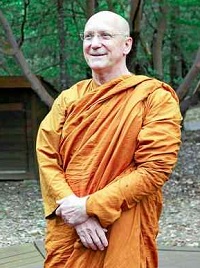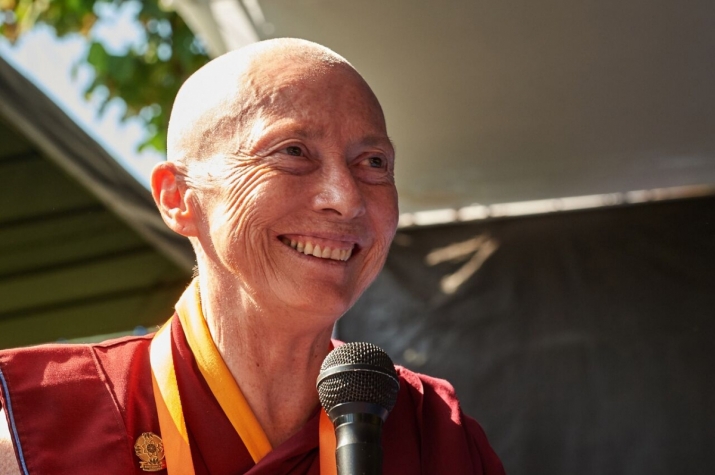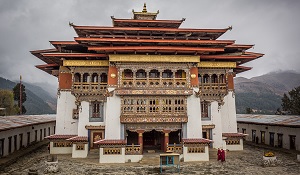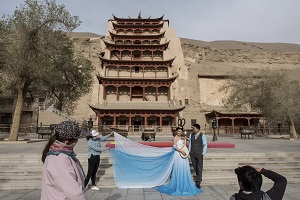Dharma companions is a blog focusing on Dharma activities, information dissemination and bringing awareness to the multifaceted aspects of Buddhism for the community from Shah Alam Buddhist Society (SABS). Postings should be of interest to Buddhist and anyone who seeks information on Buddhism. As the title suggest, we also aim to be a companion to those who seeks our company in this path that we undertake. May you be well, happy and peaceful.
Saturday, June 4, 2016
Dhammapada verses 7 and 8
"Just as a storm throws down a weak tree, so does Mara overpower the man who lives for the pursuit of pleasures, who is uncontrolled in his senses, immoderate in eating, indolent, and dissipated.
Just as a storm cannot prevail against a rocky mountain, so Mara can never overpower the man who lives meditating on the impurities, who is controlled in his senses, moderate in eating, and filled with faith and earnest effort."
Labels:
Understanding
Location:
Shah Alam, Selangor, Malaysia
Religion goes green in Taiwan pollution battle

© AFP / by Amber Wang | Heavy smoke billows from burnt offerings and incense at a Matzu temple during a Taoist ceremony in Taichung, Taiwan
TAIPEI (AFP) -
Smoke billows daily from temples across Taiwan as visitors burn incense and paper money to bring luck and prosperity -- but that familiar fragrant haze could be a thing of the past as concerns grow over ritual pollutants.
Labels:
Skillful Practice
Location:
Taipei, New Taipei City, Taiwan
Friday, June 3, 2016
Buddhist monastery in Redwood Valley marks 20th anniversary
By Karen Rifkin, The Ukiah Daily Journal, May 10, 2016
Redwood Valley, California (USA) -- In English, Abhayagiri means Fearless Mountain, serving as a refuge where one can be free from fear, knowing that the land and the community practice harmlessness, honesty and respect. The Buddha spoke of the gift of fearlessness as one of the greatest gifts we can give each other.
 Ajahn Pasanno is abbot of Abhayagiri Buddhist Monastery in Redwood Valley dedicated to the spiritual practice in the Thai Forest Tradition, a branch of the Theravada Buddhist tradition. Chris Pugh-Ukiah Daily Journal
Ajahn Pasanno is abbot of Abhayagiri Buddhist Monastery in Redwood Valley dedicated to the spiritual practice in the Thai Forest Tradition, a branch of the Theravada Buddhist tradition. Chris Pugh-Ukiah Daily JournalRiding on dirt roads through forested woodlands, standing in the back of a pickup truck with Ajahn Pasanno, the gentle and unassuming abbot of Abhayagiri Buddhist Monastery in Redwood Valley, he points out the small cabins constructed over the past 20 years that serve as dwellings for resident monks who dedicate their lives to a spiritual practice in the Thai Forest Tradition, a branch of the Theravada Buddhist tradition.
Ajahn Pasanno’s interest in spirituality was piqued during his undergraduate work at the University of Winnipeg, Canada, seeking something peaceful, something not confusing, not chaotic.
Labels:
Inspirational,
Teacher
Location:
Redwood Valley, CA 95470, USA
Thursday, June 2, 2016
Buddhist masterpieces on display for holiday
BY YIM SEUNG-HYE, Korea Joong Ang Daily, May 12,2016
Seoul, South Korea -- On Monday, a giant scroll painting of a Buddha that is said to “listen to prayers for rain,” according to the chief monk Seodam of Bukjangsa Temple in North Gyeongsang, was hung in the Buddhist Painting Hall on the second floor of the National Museum of Korea in central Seoul.
.jpg) Top: The original painting of the “Buddhist Hanging Scroll at Bukjangsa Temple” is currently on display in the Buddhist Painting Hall of the National Museum of Korea for “The Buddha Listens to Prayers” exhibition. Above: “Birth at Lumbini” is the second scene of “The Eight Scenes of Buddha’s Life,” a series of large paintings depicting the life of the Shakyamuni Buddha on display at the Hoam Art Museum. [NATIONAL MUSEUM OF KOREA, HOAM ART MUSEUM]
Top: The original painting of the “Buddhist Hanging Scroll at Bukjangsa Temple” is currently on display in the Buddhist Painting Hall of the National Museum of Korea for “The Buddha Listens to Prayers” exhibition. Above: “Birth at Lumbini” is the second scene of “The Eight Scenes of Buddha’s Life,” a series of large paintings depicting the life of the Shakyamuni Buddha on display at the Hoam Art Museum. [NATIONAL MUSEUM OF KOREA, HOAM ART MUSEUM]
Labels:
Announcement,
History
Location:
Seoul, South Korea
Buddhism vs. Christianity
Buddhism is
centered upon the life and teachings of Gautama Buddha, whereas Christianity is
centered on the Life and Teachings of Jesus Christ. Buddhism is a nontheistic
religion, i.e., it does not believe in a supreme creator being a.k.a. God. Christianity is a monotheistic religion and believes that
Christ Is the Son Of God. Buddhism is a Dharmic religion. Christianity is an offshoot of Judaism and is an Abrahamic
religion.
Buddhism versus Christianity comparison chart
Labels:
Interfaith,
Opinion
Location:
Shah Alam, Selangor, Malaysia
Wednesday, June 1, 2016
Mahanama Sutta, SN 55.21
Some people, out of fear, convert to another religion when they are near death. Here the Buddha assures that for a devoted Buddhist, that would be an unnecessary mistake.
"Suppose a man were to throw a jar of ghee or a jar of oil into a deep lake of water, where it would break. There the shards & jar-fragments would go down, while the ghee or oil would rise upward and separate out. In the same way, if one's mind has long been nurtured with conviction, nurtured with virtue, nurtured with learning, nurtured with relinquishment, nurtured with discernment, then when the body... is eaten by crows, vultures, hawks, dogs, hyenas, or all sorts of creatures, nevertheless the mind... rises upward and separates out.
"Have no fear, Mahanama! Have no fear! Your death will not be a bad one, your demise will not be bad."
Labels:
Understanding
Location:
Shah Alam, Selangor, Malaysia
“Daughters of the Buddha”: Karma Lekshe Tsomo
By Caitlin Dwyer Buddhistdoor Global 2016-03-18
 At the 14th Sakyadhita International Conference, Indonesia, 2015. Photo by Olivier Adam
At the 14th Sakyadhita International Conference, Indonesia, 2015. Photo by Olivier Adam
“We thought it would be just a small tea party,” says Venerable Karma Lekshe Tsomo. Reflecting back on the first Sakyadhita conference in Bodh Gaya, India, in 1987, she recalls a small group of Buddhist nuns gathering to talk about their circumstances. They had been struggling to support their studies financially, as well as witnessing the poverty, illiteracy, and desperation of women fleeing Tibet. “That whole week we sat under a tent, in the grass, in a circle on the ground, and discussed our circumstances—what we were thinking, what we were experiencing, the great ideals and hopes and respect that we had for the Dharma and the keen interest that we had to learn more, but finding it very difficult,” she recalls. In the end, about 1,500 people showed up to the opening ceremony, far outstripping expectations. “That’s when we realized we needed to continue the conversation,” she says.
Labels:
Inspirational,
Teacher
Location:
Bodhgaya, Bihar, India
Tuesday, May 31, 2016
The responsibility of wisdom after we come out of samādhi
Labels:
Teacher,
Understanding
Location:
Shah Alam, Selangor, Malaysia
Bhutan: A Buddhist Treasure at Gangtey Monastery
BY Robert Michael Poole, May 19, 2016
Timphu, Bhutan -- Wanderers and pilgrims who have ventured to the top of the mountains of Bhutan have had watchful eyes looking over them for centuries. The peaks of the countries rugged interior are populated by mighty yaks, who these days wander occasionally through the colorful rectangular prayer flags that decorate the mountain ridges, stamped with woodblock prints depicting the Buddha, the Dharma (teachings) and the Sangha (community).
 situated on a spur over the glacial Phobjika Valley, is a masterpiece of Buddhist architecture, created by a rural community and maintained by 100 lay monks.
situated on a spur over the glacial Phobjika Valley, is a masterpiece of Buddhist architecture, created by a rural community and maintained by 100 lay monks.(Courtesy Robert Michael Poole)
Location:
Thimphu, Bhutan
Monday, May 30, 2016
Sariputta sutta, SN 55.5
Labels:
Understanding
Location:
Shah Alam, Selangor, Malaysia
On the occasion of Visakha Bucha Day, Dhammananda Bhikkhuni fights for women's rights to serve the religion
The Bangkok Post, 20 May 2016 << Dhammananda Bhikkhuni at Songdhammakalyani Bhikkhuni Monastery in Nakhon Pathom province. << Dhammananda Bhikkhuni at Songdhammakalyani Bhikkhuni Monastery in Nakhon Pathom province.Dhammananda is recognised as the first Thai bhikkhuni (female monk) to be ordained in the Theravada tradition from Sri Lanka. Her mother, Voramai Kabilsingh, was the first Thai women to become a Mahayana bhikkhuni in 1971. Her grandmother was also a white-robed nun. Now 71, Dhammananda was in her 50s when she began her monastic life. Prior to that, she was a university professor, teaching philosophy and religion for nearly 30 years at Thammasat University. |
Labels:
Inspirational,
Skillful Practice,
Teacher
Location:
Bangkok, Thailand
Sunday, May 29, 2016
China’s ancient Buddhist grottoes face a new threat - tourists
By Simon Denyer, The Washington Post, May 16, 2016
Dunhuang, China -- At the heart of the ancient Silk Road, on the edge of the Gobi Desert, lies a centuries-old place of pilgrimage: hundreds of caves hewn from a sandstone cliff containing some of the most exquisite Buddhist frescoes and figures in the world.
 << A couple pose during a wedding photo shoot in front of the nine-story tower built around cave 96. (Gilles Sabrié/For The Washington Post)
<< A couple pose during a wedding photo shoot in front of the nine-story tower built around cave 96. (Gilles Sabrié/For The Washington Post)Abandoned for centuries, the Mogao Grottoes somehow survived everything that nature and man could throw at them, including earthquakes, floods and sandstorms. Marauding Muslim rebels, plundering European explorers and White Russian soldiers all left their mark. Rampaging Red Guards were turned away at the height of China’s Cultural Revolution.
Location:
Dunhuang, Jiuquan, Gansu, China
Subscribe to:
Comments (Atom)













